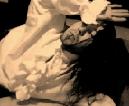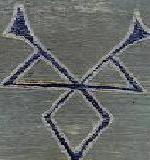 |
|
|
|
| Author |
Message |
Vorschlag

Location: Auckland
|
 Posted: Fri Oct 26, 2007 12:19 pm Posted: Fri Oct 26, 2007 12:19 pm |
 |
|
White Knight is explaining 'travelling after' or what later becomes 'upon time'.
From a later period perspective it is seen as a waste of tempo or time giving your opponent an opportunity to strike you in the time that you have wasted.
Due to the fact you must now react in less time than he/she takes to attack your defence is likely to fail against a real attack and you are likely to make an over commited defence opening yourself more so.
The earlier systems are somewhat more set in stone so the fact you have left a ward without offering a threat means your essentially dead, you just dont know it yet.
_________________
On five words hinge the entire art of the sword, in and out of armour, on horse and on foot. |
|
|
 |
Vorschlag

Location: Auckland
|
 Posted: Fri Oct 26, 2007 12:20 pm Posted: Fri Oct 26, 2007 12:20 pm |
 |
|
| Inigo wrote: | This is a no brainer question. The longsword would win.
Because this would only ever happen in a Hollywood movie, and most Hollywood directors are white.
Simple! |
Interesting idea, I tend to agree with Colin however considering for the most part Eastern Martial Arts are glorified and Western Martial Arts are ignored, not to mention these days it's becoming more and more of a sin to be european.
_________________
On five words hinge the entire art of the sword, in and out of armour, on horse and on foot. |
|
|
 |
White Knight

Location: Orcland
|
 Posted: Wed Nov 07, 2007 11:02 pm Posted: Wed Nov 07, 2007 11:02 pm |
 |
|
The more I think about it the more I believe that kendo has been changed from the swordsmanship that the samurai practised and instead became a sport restricted by rules.
There is no way that you would have used the concept of attacking solely down the centre line in a melee especially when opponents are going to attack you from the side and from many other angles.
If kendo was what the samurai actually practised without any variation from what it is today then it could only have been used in a duel between two opponents.
And if they only attacked down the centre line then it was because no one dared to challenge that school of thought with something different and breaking the accepted norm was considered dishonourable. If someone did challenge that school of thought then it would have been either one of the great masters who didn't teach anyone else what he knew or an unknown who no one would have considered honourable enough to have learnt from because he didn't have any recognition or status.
I talked to Dean and he seemed to think that maybe if kendo was what the samurai actually practised then it was because it hadn't been challenged by anyone else from another country who practised a different style of combat. Japan is a country isolated by the sea.
Great Britain on the other hand was a country that kept invading everybody else especially the poor French and the Scots.  So it's fighting styles and tactics, etc would have been challenged all the time. So it's fighting styles and tactics, etc would have been challenged all the time.
As far as I know of feudal Japan never had a sizeable navy.
Perhaps we should study Aikedo the unarmed combat of the samurai and look at how they move their feet. Do they step off to the side?
In Kendo you are taught to attack. In Aikedo I believe you are taught to respond to an attack so if the foot work is different then maybe it is different for that reason.
I can feel the need to study more about not only kendo but aikedo as well.
Perhaps a trip down to the nearest library and a visit to an aikedo school is needed.
_________________
Living History. Choose to be part of it. |
|
|
 |
Victorius
Location: IMPERIVM ROMANA: The Roman club with a Living History focus.New Roman Club
|
 Posted: Wed Nov 07, 2007 11:23 pm Posted: Wed Nov 07, 2007 11:23 pm |
 |
|
The Kendo approach may rely upon this strike, but there's more than just that to Japanese sword fighting. Between the Tokugawa Shogunate of early 1600s (preceded by the so-called Feudal era of warring factions) and the Meiji Restoration of the 1800s, when Japan opened up to the modern world, Japanese Martial Arts went down a two-fold path. I'm a little hazy on this part, but basically it went one way towards a ceremonial, non-real combat way, called DO, and on the other they maintained the offensive real combat way, called JISTU. Thus, you have JU-DO (Judo) which is one Martial Art we may have heard of. But you also have anotehr form of Ju, the JU-JITSU form, which differs in many ways.
So it is with the way of the sword. You have KEN-DO with all its rules and restrictions. But you also have KEN-JITSU, which is more like what our HEMA and WMA are doing. Any discussion of Japanese sword-fighting shouldn't focus on KEN-DO, but should look to KEN-JITSU.
_________________
VICTORIVS, BA.MA.HONS.I, IMPERIVM. ROMANA |
|
|
 |
Bogue
Sponsor

Location: Palmy
|
 Posted: Thu Nov 08, 2007 6:54 am Ken-Jutsu Posted: Thu Nov 08, 2007 6:54 am Ken-Jutsu |
 |
|
Victorious did espouse upon this topic
| Quote: | | But you also have KEN-JITSU, which is more like what our HEMA and WMA are doing. Any discussion of Japanese sword-fighting shouldn't focus on KEN-DO, but should look to KEN-JITSU. |
So I went and had a quick GOOGLE and found this,
| Quote: |
Kenjutsu The Art of Japanese Swordsmanship
By David T. Bish, Shichidan
A master swordsman must size up his opponent. No two swordsmen fight the same. Ito Ittosai, a great Japanese swordsman was reckless in his style. "Learn by being cut" was his philosophy. He believed one should be concerned more with not losing rather than winning. Proper timing is a key element of this concept.
In his book Go Rin No Sho (A Book of Five Rings), Miyamoto Musashi, remarked that his entire strategy was based on timing and rhythm. Musashi was the founder of the Nito or two sword method of fighting in Japan. It is believed that he learned the rapier and dagger techniques of the Europeans from traders in Southern Japan and used these techniques to develop his own style. |
Quoted from http://www.reddragonjujitsu.com/kenjitsu.htm
Which pretty much follows through with what Colin and TMM have repeatedly said with regard to WMA and HEMA combat. To make it easy I have emBoldened the relevant points
My $1.85 plus GST and Freight worth.
Cheers
Bogue |
|
|
 |
griff

Location: Auckland
|
 Posted: Thu Nov 08, 2007 12:56 pm Posted: Thu Nov 08, 2007 12:56 pm |
 |
|
"Perhaps we should study "Aikedo" ??
aikido |
|
|
 |
Vorschlag

Location: Auckland
|
 Posted: Thu Nov 08, 2007 6:06 pm Posted: Thu Nov 08, 2007 6:06 pm |
 |
|
Further to this as stated the period of the art in question is similar to the period of side sword eventually moving towards rapier and progressing to broadsword, sabre and smallsword.
All of which maintain the somewhat more linear (and overly growing more so) fight system of the period rather than the footwork of the previous periods your comparing them to Brett.
You must also realise who your opponents are, think about the state of the metallurgy, the armour, the weaponry etc.
Do you have need of a different form of footwork, a different type of attack etc.
Also think of the weapon in question, it is a slicing weapon more than a cut and thrust, compare it more to a sabre or sheering sword.
Much like the earlier European swords and the duelling swords of its period it is not designed for taking out heavily armoured troops, (unlike the duelling swords of it's period) it is designed to take out multiple opponents in a fast and effective manner.
In my opinion it is more fitted to be placed against a sabre, sidesword, broadsword, backsword, sheering sword, shortsword or smallsword as they are more fitting to it's period and share more of a linear fight system.
Alternatively as stated, the full armoured 15th-16th century knight wins hands down against the samurai of his period just because the katana cant handle the knights armour.
_________________
On five words hinge the entire art of the sword, in and out of armour, on horse and on foot. |
|
|
 |
White Knight

Location: Orcland
|
 Posted: Sun Nov 11, 2007 11:14 pm Posted: Sun Nov 11, 2007 11:14 pm |
 |
|
I have found this particular topic of conversation to be very intereseting and have learnt more about Japanese martial arts from it.
Its good to be able to have a decent discussion with other people without any political or emotional rubbish being brought in.
_________________
Living History. Choose to be part of it. |
|
|
 |
Vorschlag

Location: Auckland
|
 Posted: Mon Nov 12, 2007 5:39 pm Posted: Mon Nov 12, 2007 5:39 pm |
 |
|
Wait, wait, you mean... a logical conversation.....over the internet, surely you must be kidding, such things are like unicorns, dragons and ladies they only exist in fairytales and the like.
_________________
On five words hinge the entire art of the sword, in and out of armour, on horse and on foot. |
|
|
 |
White Knight

Location: Orcland
|
 Posted: Wed Nov 14, 2007 9:43 am Posted: Wed Nov 14, 2007 9:43 am |
 |
|
T.M.M. Yes exactly! How rare!
No emotional garbage or ego screeching.
_________________
Living History. Choose to be part of it. |
|
|
 |
conal
Site Admin
|
 Posted: Wed Nov 14, 2007 7:52 pm Posted: Wed Nov 14, 2007 7:52 pm |
 |
|
What about a light sabre?
Those things are just plain dangerous. I mean you could be hiding behind a wall and fss-zoom--- cut in half, just like that.
I used to work for a guy called Masao Suenaga, of Suenaga Saketen, in Shibushi-Cho, Kagoshima, Japan.
One day he said some thing I didn't understand again. But basically I understood it to mean "the chisel" as a mechanism of counting, particularly used for swords... and chisels, I guess. |
|
|
 |
huscarl

Location: in the back of your mind
|
 Posted: Wed Nov 14, 2007 10:06 pm Posted: Wed Nov 14, 2007 10:06 pm |
 |
|
thats a point light sabre in the hands of say patch ohh the fort battle would be fun 
guess my sheild wont b much good to me 
_________________
hail Fraja. |
|
|
 |
Vorschlag

Location: Auckland
|
 Posted: Wed Nov 14, 2007 10:44 pm Posted: Wed Nov 14, 2007 10:44 pm |
 |
|
As much as I love eighteenth century swordsmanship, an enlightenment swordsman with a sabre would be destroyed by a medieval swordsman due to the difference in footwork.
i.e the knight or even man at arms beats the pirate.
_________________
On five words hinge the entire art of the sword, in and out of armour, on horse and on foot. |
|
|
 |
conal
Site Admin
|
 Posted: Thu Nov 15, 2007 11:16 am Posted: Thu Nov 15, 2007 11:16 am |
 |
|
Edward Teach vs Gui du Lusignan
The Pirate wins.
Next. |
|
|
 |
Vorschlag

Location: Auckland
|
 Posted: Thu Nov 15, 2007 5:48 pm Posted: Thu Nov 15, 2007 5:48 pm |
 |
|
A 18th century English pirate vs a 13th century French Knight, remove the inaccurate flintlocks and the knights maille protection and my moneys still on blackbeard dying a feeble death from lack of geometrical swordsmanship.
_________________
On five words hinge the entire art of the sword, in and out of armour, on horse and on foot. |
|
|
 |
|
|
 Please read the terms of use
Please read the terms of use
 Contact the Site Admin
Contact the Site Admin

